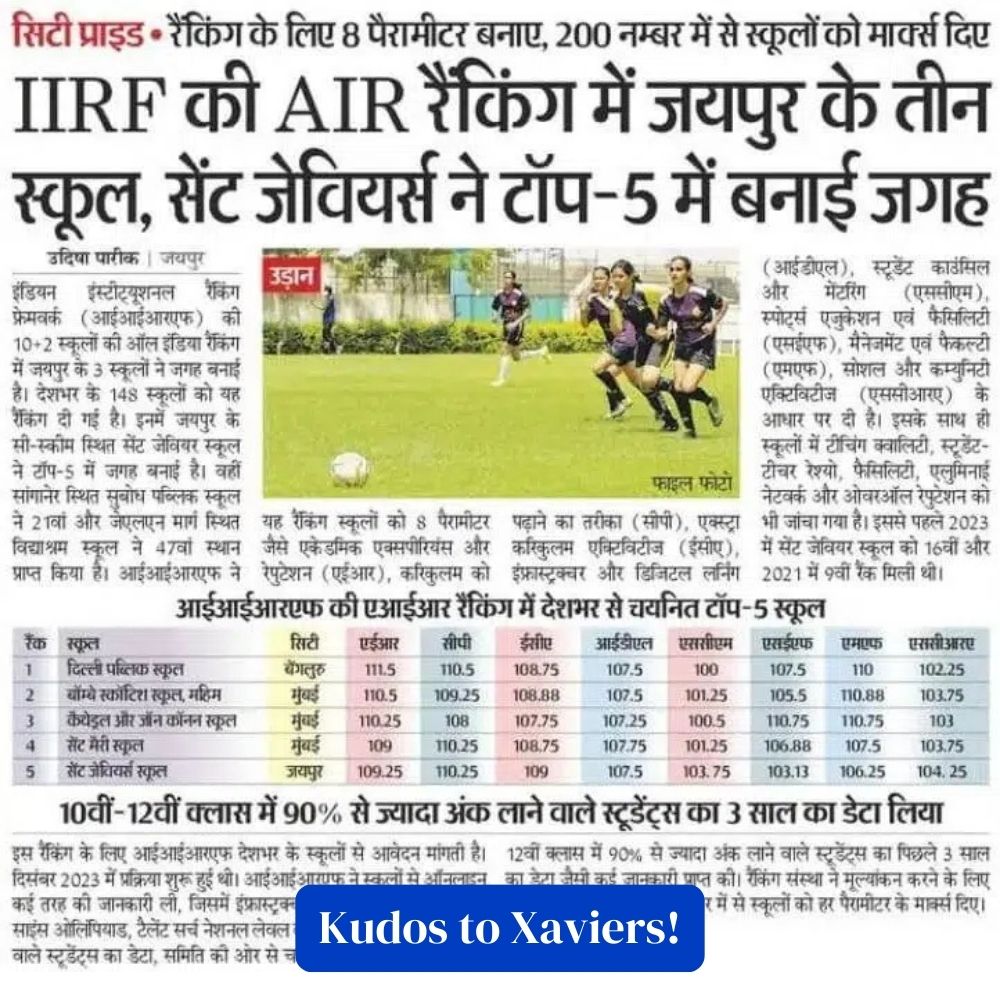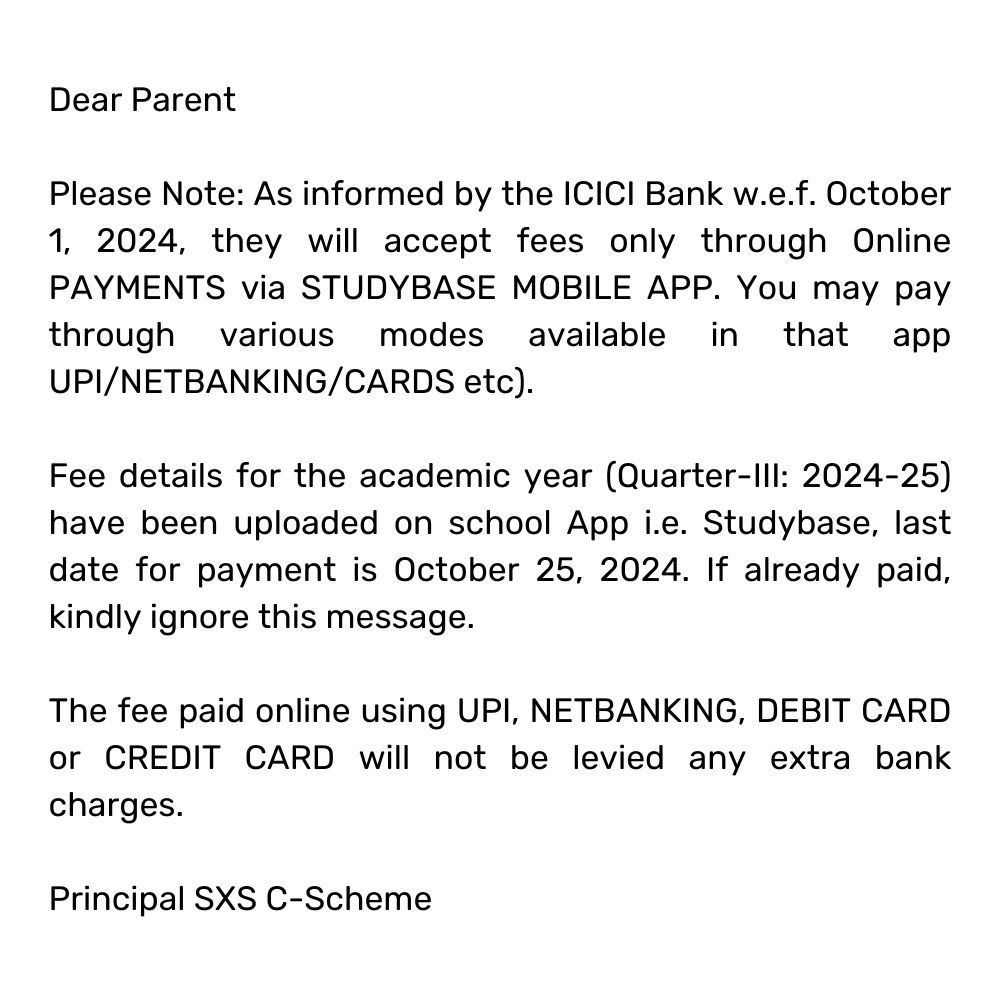Home
St. Xavier’s Senior Secondary School, Jaipur is a Christian minority school under the management of the Jesuits, an international Christian Religious Order, known as the Society of Jesus.
St. Xavier’s School for boys was founded in July, 1941 under the name of St. Mary’s Boy’s School in the Roman Catholic Church Compound at Ghat Gate, Jaipur by Rev. Fr. Ignatius, O.F.M. Cap. In July 1943 its management was entrusted to the Jesuit Fathers, renowned for their educational work. The school was transferred to the present site and renamed St. Xavier’s School in January, 1945, and still later as St. Xavier’s Sr. Sec. School.
About
St. Xavier's School
The Society of Jesus, founded by St. Ignatius of Loyola in 1540, has, since its origin, been active in the field of education throughout the world. In India, the Society of Jesus is at present responsible for more than one hundred high schools and 25 colleges in which over a lakh and a half, young people belonging to every creed, social class, community and linguistic group are educated through the medium of English and regional languages. These institutions are part of the Catholic Church’s effort to share in the country’s educational undertaking. This effort, while particularly responsible to the Christian community, has always been at the service of the whole nation. Thus in these institutions, recognised as Christian Minority Institutions, the religious beliefs of all students are treated with respect.
Important
Links
Dear Parents, Students and well wishers, With the advent of National Education Policy (NEP 2020) many innovative ideas are presented to us by the government in the school and college education. The structure of school education has been remodelled from 10+2 system to 5+3+3+4 system, i.e., Foundational (5 years = pre-school to grade 2), Preparatory (3years = grades 3-5), Middle (3 years = grades 6-8) and Secondary (4years = grades 9-12). The new system lays grater emphasis on experiential learning based on learning outcomes than mere rote learning of facts. What is envisaged through this attempt is to develop good human beings capable of rational thought and action, possessing compassion and empathy, courage and resilience, scientific temper and creative imagination, with sound ethical moorings and values. It aims at building an equitable, inclusive, and plural society.
We at Xavier’s have been continuing the mission of shaping young minds since 1941. The changing educational scenario in the post Covid-19 era and the implementation of NEP-2020 guidelines calls for constant updating and reinventing ourselves to be relevant in the present context. At the same time, we cannot compromise on the values and pillars of Jesuit Educational pedagogy and practice i.e., Competence, Conscience, Compassion and Commitment. Duties precede rights. Let us transcend our limitations and exhibit better work ethics. I invite all the stakeholders to be partners in the mission of education and to work towards shaping a better India with the values enshrined in our Constitution.
Sincerely,
Fr. M. Arockiam, SJ
Principal
Dear Parents, Students and well wishers, With the advent of National Education Policy (NEP 2020) many innovative ideas are presented to us by the government in the school and college education. The structure of school education has been remodelled from 10+2 system to 5+3+3+4 system, i.e., Foundational (5 years = pre-school to grade 2), Preparatory (3years = grades 3-5), Middle (3 years = grades 6-8) and Secondary (4years = grades 9-12). The new system lays grater emphasis on experiential learning based on learning outcomes than mere rote learning of facts. What is envisaged through this attempt is to develop good human beings capable of rational thought and action, possessing compassion and empathy, courage and resilience, scientific temper and creative imagination, with sound ethical moorings and values. It aims at building an equitable, inclusive, and plural society.
We at Xavier’s have been continuing the mission of shaping young minds since 1941. The changing educational scenario in the post Covid-19 era and the implementation of NEP-2020 guidelines calls for constant updating and reinventing ourselves to be relevant in the present context. At the same time, we cannot compromise on the values and pillars of Jesuit Educational pedagogy and practice i.e., Competence, Conscience, Compassion and Commitment. Duties precede rights. Let us transcend our limitations and exhibit better work ethics. I invite all the stakeholders to be partners in the mission of education and to work towards shaping a better India with the values enshrined in our Constitution.
Sincerely,
Fr. M. Arockiam, SJ
Principal
- Dear parents, In view of the summer holidays (from 18-05-2024 to 30-06-2024) the school will be closed. Students will report to school on 01-07-2024 @ 07:30 a.m. Principal SXS, C-Scheme
Upcoming Events
Life @
Xavier's
"Congratulations"

JEE Mains:- 99.96%
Arjun Beniwal
CLEARED NATIONAL MATHEMATICS TALENT CONTEST (INTER LEVEL) & INDIAN OLYMPIAD (MATHS)

JEE Mains:- 99.95%
Naman Goyal
AIR 1 IN TECHNOTHLON (BY IIT GUWAHATI) STOOD IN TOP 1% (NSEP)

JEE Mains:- 99.85%
Naveen Bhatia
CENTRE TOP 10% (NSEP & NSCE - 2024)

JEE Mains:- 99.70%
Niharika Bansal
HOUSE CAPTAIN, NATIONAL LEVEL SWIMMER, XAVIERS FAIR PLAY AWARD HOLDER, VP XAVIERS PHOTOGRAPHY CLUB

JEE Mains:- 99.60%
Dhruv Narwani
TOP 10% (NMTC), GOLD MEDEL IN SOF (STAGE-2)

JEE Mains:- 99.25%
Parth Sharma
SCIENCE CLUB EXECUTIVE, RAJYA PURASKAR AWARDEE (SCOUTS AND GUIDES), SCHOOL PREFECT

JEE Mains:- 99.01%
Ritwik Khandelwal
STATE LEVEL PLAYER (FOOTBALL)

JEE Mains:- 98.57%
Vedant Sharma
98.57 PERCENTILE

JEE Mains:- 98.44%
Shivam Pathak
HEAD BOY 2024-25, SCIENCE CLUB EXECUTIVE

JEE Mains:- 97.99%
Janak Rathi
REDS HOUSE - BEST ACTOR

JEE Mains:- 97.20%
Apaar Agarwal
PRESIDENT - SCIENCE CLUB SCHOOL PREFECT

JEE Mains:- 96.24%
Venu Gopal
STSE SCHOLAR RANK-14 1ST IN NARESH PARDAL GK QUIZ

JEE Mains:- 95.96%
Yutika Chhabara
STATE LEVEL VOLLEYBALL PLAYER, SCIENCE CLUB EXECUTIVE, NCC CADET

JEE Mains:- 95.62%
Anik Jain
CENTRE TOP 10% (NSEA & NSEC - 2024)

JEE Mains:- 94.35%
Shreyansh Agarwal
MEMBER OF SCIENCE CONGRESS

JEE Mains:- 90.44%
Rijul Jain
SCIENCE CLUB (JOINT SECRETARY), RAJYA PURASKAR AWARDEE (SCOUTS AND GUIDES)

JEE Mains:- 90.27%
Ameyatman Roy
90.27 PERCENTILE

CLAT:- AIR 26 | NLU,Delhi:- AIR 44
Mokesh Singh
SCHOOL PREFECT

CLAT:- AIR 50
Raghav Jain
SCHOOL PREFECT


